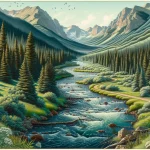A unique corridor of plants winds its way from the foothills through the suburbs of Westminster, Thornton, and Northglenn before joining the South Platte River. Though seemingly dry at times, the creek sustains a vibrant ecosystem and offers visitors a chance to experience the authentic flavor of Colorado.
In This Article
TL;DR
- Big Dry Creek is a unique Front Range destination with rich ecological diversity and cultural heritage.
- Visitors can hike nature trails, observe wildlife, attend cultural events, learn about conservation efforts, and more.
- The area balances outdoor recreation with environmental preservation and community engagement.
Destination Overview: Big Dry Creek, Colorado
As the name suggests, Big Dry Creek appears parched during parts of the year. But this belies the vibrancy of the surrounding habitat. The creek flows through open spaces and parks with cottonwood galleries, wetland ponds, grassland meadows, and riparian woodlands. Over 200 species of birds flock to these environs, along with foxes, coyotes, deer, and more.
The Big Dry Creek Trail traces the waterway for nearly 13 miles as it meanders through neighborhoods and parks. Side trails and connectors create an extensive network catering to hikers, bikers, and equestrians. Interpretive signs educate visitors about the watershed, wildlife, and native plants. Benches and picnic areas provide places to relax and take in scenic views with the Rocky Mountains as a backdrop.
Recreational amenities intermix with venues that celebrate Front Range heritage. Community parks host festivals that showcase local music, arts, and cuisine. Historic sites chronicle how early settlers utilized the creek for farming. And nature centers offer programs on regional ecology, conservation, and photography.
Big Dry Creek balances natural splendor with opportunities to engage with small-town charm, making it an alluring Front Range escape.
Local Experiences and Culture
While the creek acts as a unifying thread, each community along its route contributes something unique. Westminster’s Little Dry Creek Park harbors blue heron rookeries, fox kits playing among the cattails, and even the occasional bull snake sunning itself on the path. Thornton’s parks present views of the creek juxtaposed with the Denver skyline. And Northglenn’s E.B. Rains Jr. Memorial Park contains historic farm structures interspersed with flower gardens.
Community events are the best way to soak up local traditions. Northglenn hosts its annual Harvest Fest in October with bands, beer, chili cookoffs, and more. Thornton’s Arts and Culture events include Chalk Art Festivals that turn streets into canvases. And Westminster’s Summer Festivals feature over 30 free concerts, movies, and activities in parks throughout the city.
Of course, the creek itself offers the most authentic experience. Pull up a fishing pole at the 11-mile or 144th Avenue reservoirs. Pack a picnic lunch to enjoy at tables along the trail. Or sit on a bench listening to the red-winged blackbirds while watching the cottonwoods waver in the breeze. Big Dry Creek offers a chance to slow down and savor Colorado’s small-town culture.
Outdoor Activities
The lifeblood of Big Dry Creek lies in its outdoor offerings, weaving together riparian, plains, and mountain ecosystems. The creek’s trail system caters to cyclists, joggers, and equestrians with mileage markers, underpasses, and alternating paved and soft-surface options. Families flock to the numerous parks lining its bawithygrounds, sports fields, fishing ponds, and shaded picnic shelters.
But it’s the natural landscapes that steal the show. Over 200 species of birds inhabit the corridor’s wetland ponds, cottonwood forests, cattail marshes, and grassland meadows. Deer, foxes, coyotes, beavers, bullsnakes, and more also dwell in these environs. The diversity of flora and fauna provides a wildlife viewing bonanza for novice nature lovers and birding experts alike.
The City of Westminster and Adams County have also implemented water conservation efforts to sustain creek vitality. Stormwater detention ponds naturally filter runoff before it enters the watershed. Educational signage raises awareness about responsible water usage. Voluntary flow restrictions during droughts help maintain aquatic habitats. These measures allow continued recreational usage while promoting ecological health.
With options from adrenaline-pumping to serenely relaxing, Big Dry Creek satiates any outdoor appetite.
Educational Opportunities
A visit to Big Dry Creek also nourishes the mind through numerous educational opportunities. Interpretive signs along the trails describe wildlife, native plants, floodplain ecology, and watershed dynamics. Nature centers offer guided hikes, birding sessions, and hands-on programming for kids. Specific venues also highlight cultural heritage.
Westminster’s Little Dry Creek Nature Center contains raptor enclosures housing red-tailed hawks, great horned owls, and American kestrels. Naturalists provide demonstrations showcasing the birds’ unique adaptations and conservation needs. The Birds of Prey exhibit offers an up-close look at these hunters’ aerobatic skills.
Thornton’s Carpenter Park Nature Center lies adjacent to wetland ponds teeming with ducks, geese, and shorebirds. The property includes native grasslands and a remnant farmstead from the late 1800s. Inside, it it displays profile area wildlife while the hands-on Discovery Room lets kids investigate natural artifacts.
Northglenn’s E.B. Rains Jr. Memorial Park contains the historic Hillhurst Farm, once owned by Margaret Hillhurst. Visitors can take self-guided tours to explore the 1898 farmhouse, 1905 barn, and outbuildings, while displays describe early 20th century farm life. Llamas, horses, chickens, and goats reside on site, adding to the agricultural ambiance.
With options spanning environmental, cultural, and historical education, Big Dry Creek feeds minds and bodies.
Ecological Significance
Though seemingly humble, Big Dry Creek plays a vital ecological role. As one of the major tributaries feeding the South Platte Basin, the creek’s flows contribute to downstream environments. Wetland ponds and backwater areas provide nurseries for fish, frogs, and other aquatic species. During migrations, waterfowl and shorebirds rely on these habitats for nesting and feeding grounds. And mammals from deer to coyotes traverse the riparian buffers while also preying on fish and waterfowl.
During floods, the creek’s banks and braided channels absorb and slow surging waters, protecting developed areas from inundation. Simultaneously, these high-flow events transport nutrient-rich sediments that replenish plant communities and wildlife habitats. Some sections also harbor rare xeric tallgrass prairie remnants. The creek serves as a wildlife corridor, allowing animals to safely disperse and migrate along the Front Range.
As the creek faces increasing pressures from climate change, pollution, and urbanization, efforts are underway to ensure its ecological integrity. Westminster, Thornton, Northglenn, and Adams County have implemented water conservation initiatives to maintain healthy flows. Extensive trail networks balance recreation with habitat preservation. And organizations like Clear Creek Watershed Foundation provide community education coupled with ecological restoration projects.
Though understated, healthy creeks equate to healthy communities along Colorado’s Front Range. Through sound resource management, the allure of Big Dry Creek will continue flowing for generations.
FAQ
How long is Big Dry Creek?
The creek flows for approximately 24 miles from the foothills through Westminster, Thornton, Northglenn, and into Adams County. Over 12 miles of trail follow the riparian corridor.
What is the best way to experience Big Dry Creek?
Walk or bike the trails to spot wildlife, take in scenic views, and experience nature. You can also attend a community festival or event to appreciate the local culture.
What is the creek’s annual flow pattern?
Flows swell in spring with snowmelt and dip mid-summer during hot, dry periods. Brief intense rainstorms can also cause sudden flooding. The creek is mostly dry by early winter.
Why are the wetland ponds important?
These ponds filter pollutants, mitigate floods, recharge groundwater, and provide essential habitats for fish, waterfowl, amphibians, and aquatic insects.
What conservation efforts are in place?
Communities have implemented water conservation measures, stormwater management, pollution controls, habitat restoration projects, protected open spaces, and more.
How can I learn more about Big Dry Creek?
Visit one of the nature centers in Westminster, Thornton or Northglenn. Check city websites for maps, programs, and historical information. Or contact Clear Creek Watershed Foundation to volunteer.
The above FAQ covers common visitor inquiries related to experiencing and understanding the essence of Big Dry Creek. Let the flow of adventure begin!






